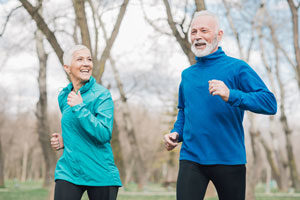Being active can help you improve your health and feel better, says the Department of Health and Human Services. It can lower your blood pressure and reduce your risk of chronic diseases, like type 2 diabetes and certain cancers. Physical activity can also boost your mood and help sharpen your focus. In its new Physical Activity Guidelines for Americans, HHS says that adults need at least 150 minutes of moderate-intensity physical activity per week. You can start with just 5 minutes at a time. Swim, garden, walk the dog, dance, or bike your way to feeling better. Strengthening your muscles is important too. At least two days each week, do some push-ups or lift weights. Children ages three to five should be physically active for at least three hours throughout the day. Kids six through 17 need at least one hour per day. All of your physical activity adds up. Moving more often throughout the day can help you get enough activity.
Pay attention
Adults with obesity who attended group sessions teaching mindfulness-based eating techniques lost an average of 2.85 kg more than similar adults who attended group classes without mindful eating strategies, according to findings published in The Journal of Clinical Endocrinology & Metabolism and reported by Helio.com. “Our study has shown that mindfulness techniques can improve eating behavior and facilitate weight loss in patients with obesity attending specialist weight management service,” said Petra Hanson, MBChB, MRCP, AFHEA, a clinical research fellow at Clinical Sciences Research Laboratories, University Hospitals Coventry and Warwickshire, U.K. “Mindfulness taught in such a setting can also improve patients’ confidence and ability to manage weight in the long term. It is a very scalable intervention that can be applied to everyone.”
Housework for brainiacs
Now there’s no excuse for not doing more housework. Even simple housework, like cooking and cleaning, may make a difference in brain health, according to researchers at Rush University Medical Center in Chicago. In the last years of research before death, each participant in the Rush study wore an activity monitor called an accelerometer, similar to a Fitbit, which measured physical activity around the clock – everything from small movements, such as walking around the house, to more vigorous movements, like exercise routines. Researchers collected and evaluated 10 days of movement data for each participant and calculated an average daily activity score. The findings showed that higher levels of daily movement were linked to better thinking and memory skills, as measured by the yearly cognitive tests. And when researchers analyzed brain tissue under a microscope, this finding turned out to be the case even for individuals with at least three signs of Alzheimer’s disease, such as amyloid plaques and neurofibrillary tangles. Even though these individuals might have been diagnosed with Alzheimer’s, 30 percent of them had “normal” cognition at death.
What to do about vaping?
Health authorities agree: Teen vaping is an epidemic that affects some 3.6 million underage users of Juul and other e-cigarettes, reports the New York Times. But no one seems to know the best way to help teenagers who may be addicted to nicotine. E-cigarettes heat a liquid solution that usually contains nicotine into an inhalable vapor. Federal law prohibits sales to those under 18, though many high schoolers report getting them from older students or online. In recent months, government officials have rolled out a series of proposals aimed at keeping the products away from youngsters, including tightening sales in convenience stores and online. In November, vaping giant Juul voluntarily shut down its Facebook and Instagram accounts and pulled several flavors out of retail stores. But there’s been little discussion of how to treat nicotine addiction in children as young as 11 years old. Physicians who treat young people now face a series of dilemmas: The anti-smoking therapies on the market – such as nicotine patches and gums – are not approved for children, due to lack of testing or ineffective results. And young people view the habit as far less risky than smoking, which poses another hurdle to quitting.
Unhappy meal
A hamburger a week, but no more – that’s about as much red meat people should eat to do what’s best for their health and the planet, according to a report by EAT, a Stockholm-based nonprofit, and published in the medical journal Lancet, reports the New York Times. Eggs should be limited to fewer than about four a week, and dairy foods should be about a serving a day, or less. The report from a panel of nutrition, agriculture and environmental experts recommends a plant-based diet, and encourages whole grains, beans, fruits and most vegetables. Added sugars should be limited, as should refined grains, such as white rice, and starches, like potatoes and cassava. It says red meat consumption on average needs to be slashed by half globally, though reductions would need to be more dramatic in richer countries like the United States.
Older adults: Mind your protein
Older adults need to eat more protein-rich foods when losing weight, dealing with a chronic or acute illness, or facing a hospitalization, according to a growing consensus among scientists, reports Kaiser Health News. During these stressful periods, aging bodies process protein less efficiently and need more of it to maintain muscle mass and strength, bone health and other essential physiological functions. Even healthy seniors need more protein than when they were younger to help preserve muscle mass, experts suggest. Yet up to one-third of older adults don’t eat an adequate amount due to reduced appetite, dental issues, impaired taste, swallowing problems and limited financial resources. Combined with a tendency to become more sedentary, this puts them at risk of deteriorating muscles, compromised mobility, slower recovery from bouts of illness and the loss of independence.

